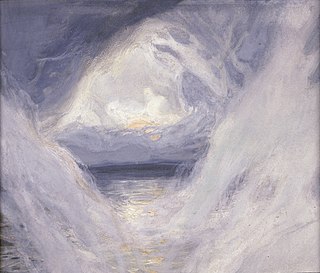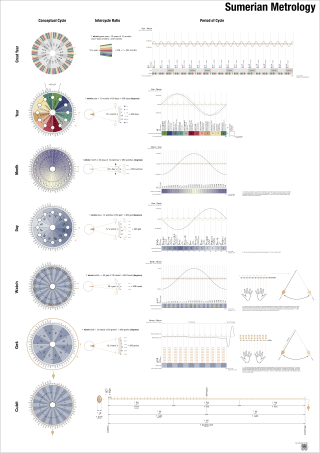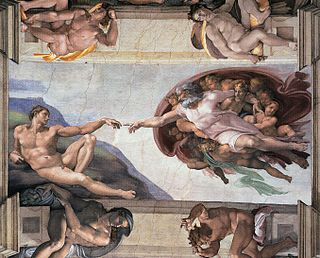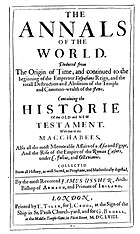
The zodiac is a belt-shaped region of the sky that extends approximately 8° north and south of the ecliptic, the apparent path of the Sun across the celestial sphere over the course of the year. Also within this zodiac belt appear the Moon and the brightest planets, along their orbital planes. The zodiac is divided along the ecliptic into 12 equal parts ("signs"), each occupying 30° of celestial longitude. These signs roughly correspond to the astronomical constellations with the following modern names: Aries, Taurus, Gemini, Cancer, Leo, Virgo, Libra, Scorpio, Sagittarius, Capricorn, Aquarius, and Pisces.

James Ussher was the Church of Ireland Archbishop of Armagh and Primate of All Ireland between 1625 and 1656. He was a prolific Irish scholar and church leader, who today is most famous for his identification of the genuine letters of the church father, Ignatius of Antioch, and for his chronology that sought to establish the time and date of the creation as "the entrance of the night preceding the 23rd day of October... the year before Christ 4004"; that is, around 6 pm on 22 October 4004 BC, per the proleptic Julian calendar.
The Iranian calendar or Iranian chronology are a succession of calendars created and used for over two millennia in Iran, also known as Persia. One of the longest chronological records in human history, the Iranian calendar has been modified many times for administrative purposes. The most influential person in laying the frameworks for the calendar and its precision was the 11th century Persian polymath, Omar Khayyam. The modern Iranian calendar is currently the official civil calendar in Iran.

Dating creation is the attempt to provide an estimate of the age of Earth or the age of the universe as understood through the creation myths of various religious traditions. Various traditional beliefs hold that the Earth, or the entire universe, was brought into being in a grand creation event by one or more deities. After these cultures develop calendars, a question arises: Precisely how long ago did this creation event happen?

The Scofield Reference Bible is a widely circulated study Bible. Edited and annotated by the American Bible student Cyrus I. Scofield, it popularized dispensationalism at the beginning of the 20th century. Published by Oxford University Press and containing the entire text of the traditional, Protestant King James Version, it first appeared in 1909 and was revised by the author in 1917.

The antediluvian period is the time period chronicled in the Bible between the fall of man and the Genesis flood narrative in biblical cosmology. The term was coined by Thomas Browne. The narrative takes up chapters 1–6 of the Book of Genesis. The term found its way into early geology and science until the late Victorian era. Colloquially, the term is used to refer to any ancient and murky period.

Peleg is mentioned in the Hebrew Bible as one of the two sons of Eber, an ancestor of the Ishmaelites and the Israelites, according to the Generations of Noah in Genesis 10–11 and 1 Chronicles 1.

The Babylonian calendar was a lunisolar calendar used in Mesopotamia from around the second millennium BCE until the Seleucid Era, and it was specifically used in Babylon from the Old Babylonian Period until the Seleucid Era. The civil lunisolar calendar was used contemporaneously with an administrative calendar of 360 days, with the latter used only in fiscal or astronomical contexts. The lunisolar calendar descends from an older Sumerian calendar used in the 4th and 3rd millennia BCE.

Birkat Hachama refers to a rare Jewish blessing that is recited to the Creator, thanking God for creating the sun. The blessing is recited when the Sun completes its cycle every 28 years on a Tuesday at sundown. Jewish tradition says that when the Sun completes this cycle, it has returned to its position when the world was created. Because the blessing needs to be said when the Sun is visible, the blessing is postponed to the following day, on Wednesday morning.
The genealogies of Genesis provide the framework around which the Book of Genesis is structured. Beginning with Adam, genealogical material in Genesis 4, 5, 10, 11, 22, 25, 29–30, 35–36, and 46 moves the narrative forward from the creation to the beginnings of the Israelites' existence as a people.

Anno Mundi, abbreviated as AM or A.M., or Year After Creation, is a calendar era based on the biblical accounts of the creation of the world and subsequent history. Two such calendar eras of notable use are:

The March equinox or northward equinox is the equinox on the Earth when the subsolar point appears to leave the Southern Hemisphere and cross the celestial equator, heading northward as seen from Earth. The March equinox is known as the vernal equinox in the Northern Hemisphere and as the autumnal equinox in the Southern Hemisphere.

The majority of Egyptologists agree on the outline and many details of the chronology of Ancient Egypt. This scholarly consensus is known as the Conventional Egyptian chronology, which places the beginning of the Old Kingdom in the 27th century BC, the beginning of the Middle Kingdom in the 21st century BC and the beginning of the New Kingdom in the mid-16th century BC.

Anno Lucis is a dating system used in Masonic ceremonial or commemorative proceedings, which is equivalent to the Gregorian year plus 4000. It is similar to Anno Mundi.

The Byzantine calendar, also called the Roman calendar, the Creation Era of Constantinople or the Era of the World, was the calendar used by the Eastern Orthodox Church from c. 691 to 1728 in the Ecumenical Patriarchate. It was also the official calendar of the Byzantine Empire from 988 to 1453 and of Kievan Rus' and Russia from c. 988 to 1700. This calendar was used also in other areas of the Byzantine commonwealth such as in Serbia, where it is found in old Serbian legal documents such as Dušan's Code, thus being referred to as the Serbian Calendar as well.

The chronology of the Bible is an elaborate system of lifespans, 'generations', and other means by which the Masoretic Hebrew Bible measures the passage of events from the creation to around 164 BCE. It was theological in intent, not historical in the modern sense, and functions as an implied prophecy whose key lies in the identification of the final event. The passage of time is measured initially by adding the ages of the Patriarchs at the birth of their firstborn sons, later through express statements, and later still by the synchronised reigns of the kings of Israel and Judah.

Seder Olam Rabbah is a 2nd-century CE Hebrew language chronology detailing the dates of biblical events from creation to Alexander the Great's conquest of Persia. It adds no stories beyond what is in the biblical text, and addresses such questions as the age of Isaac at his binding and the number of years that Joshua led the Israelites. Tradition considers it to have been written about 160 CE by Jose ben Halafta, but it was probably also supplemented and edited at a later period.
Artystone also known as Irtašduna in the Fortification tablets, was a Achaemenid princess, daughter of king Cyrus the Great, and sister of Cambyses II, Atossa and Smerdis. Along with Atossa and her niece Parmys, Artystone married king Darius I. It is argued that by marrying the female offspring of Cyrus, the founder of the empire, the new king aimed to prevent his rule from being contested, since Darius himself was not of royal blood.
Adams Synchronological Chart or Map of History, originally published as Chronological Chart of Ancient, Modern and Biblical History is a wallchart that graphically depicts a Biblical genealogy alongside a timeline composed of historic sources from the history of humanity from 4004 BC to modern times.
The scroll traces the course of human history from 4004 BC to 1883 using time lines, flow charts, and family trees that encompass settlements, countries, empires and civilizations around the world, from Babylon, Sparta, and China to Italy, Russia, and Wales. The text is accompanied by pictures of landmark events and personalities, including architectural monuments like the pyramids, history-changing tools and weapons, inventions, and portraits of famous rulers, adventurers, scientists, cultural figures.. and maps drawn by John Alsop Paine *National Museum of American History
Biblical literalist chronology is the attempt to correlate the historical dates used in the Bible with the chronology of actual events, typically starting with creation in Genesis 1:1. Some of the better-known calculations include Archbishop James Ussher, who placed it in 4004 BC, Isaac Newton in 4000 BC, Martin Luther in 3961 BC, the traditional Hebrew calendar date of 3760 BC, and lastly the dates based on the Septuagint, of roughly 4650 BC. The dates between the Septuagint & Masoretic are conflicting by 650 years between the genealogy of Arphaxad to Nahor in Genesis 11:12-24. The Masoretic text, which lacks the 650 years of the Septuagint, is the text used by most modern Bibles. There is no consensus of which is right, however, without the additional 650 years in the Septuagint, according to Egyptologists the great Pyramids of Giza would pre-date the Flood and provide no time for Tower of Babel event.


















